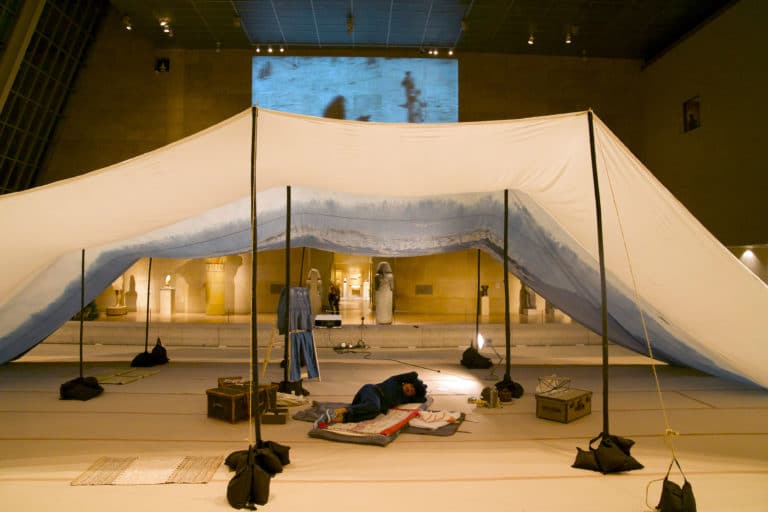The Bagri Foundation recently supported a durational performance piece, entitled Lands, Waters and Skies by the Goa-based artist Nikhil Chopra at The Metropolitan Museum of Art, New York. Our Head of Arts Chelsea Pettitt reflects on the experience.
“As a performance artist, Chopra collapses the boundaries between theatre and several other artistic endeavours including live art, painting, photography, sculpture and installation. Lands, Waters and Skies is part of a yearlong residency at the Museum supported by us. Nearly 30,000 people engaged with Chopra’s nine day public-facing project which took place throughout the galleries. It was the longest indoor and most meticulously planned performance he has done to date, and the Met’s first ‘live-in’ artist in its 150 year history.
Drawing from his theatre background, Chopra’s performances always take on personal transformations. Hair comes, then goes, outfits change, sets are constructed and torn down, make-up is applied and characters are drawn from local history and collections. New stories are told as Chopra finds ways to explore unseen narratives within museum collections, documenting these through video and photography as he goes.
After three visits and months of researching the Met collections, Chopra took note of the visitors, the objects and the historical narratives, and began to chart the locations for his theatrical transformation. Exploring the notions of migration and displacement, Chopra’s journey began as a ‘wanderer’ outside the gallery on the steps, bringing bags, blankets and a trunk into the Great Hall, and eventually setting up in the Egyptian gallery. The wanderer slowly began to raise his tent near the famous Temple of Dendur – which he says ‘epitomises the role of the museum and how it positions itself as the saviour of cultural heritage’ – where he slept, ate, and began to paint a sky.
One visitor described seeing Chopra at work and said ‘It’s kind of like another dimension/portal to a different world – where a man is living in a tent in the desert with minimal possessions and decided to create’. Others passed by whilst he was napping, uttering ‘is that a man?’. Not everyone understood what was happening in the Met galleries, but Chopra’s aim was to slow them down, to make them look, to take his photo and to analyse and question what his intentions were. Accompanied by a specially-made soundtrack for each space, Chopra looked at museum visitors directly in the eyes, wanting to make a connection with each one of them. He had a way of making you feel intensely rooted in the gallery, in the here and now; acknowledging the space you are taking up and his act of being an object to you; one to photograph like the other sculptures in the galleries.
Working closely with the security guards, curators, ushers and technicians, Chopra moved through the galleries to arrive at the Medieval Hall. Inspired by a mask from the Asmat Tribe in Papua New Guinea, he changed into a red outfit with black streaks and began to paint a rocky landscape and cliff, before eventually finding his way into the Lehman Wing where an Italian fountain takes centre stage.
Chopra’s performances subtly raise issues around colonial violence and conquest and Lands, Waters and Skies is no different. From a temple that was ‘saved from ruin’ in Egypt to a mask ‘collected’ from a tribe which had little to no contact with the outside world, he found a way to own these histories and present them back to the museum within the context of his identity. He states ‘I come from contemporary India and I carry the subcontinent’s colonial past with me,’ and continues ‘I try to hold a mirror up to the world to capture what is being reflected’.
Wearing a sparkling gown with mirrors (an ongoing motif), Chopra continued to paint water, a frothing sea, on his giant canvas tent. A museum visitor described it as ‘a calming, visual art performance that seems to be transporting you to the edge of the river.’ After three days in the Lehman Wing, his final journey culminated in a slow walk back through the galleries, donning a mirrored mask (made up of ideas from masks around the collection), evoking a shaman-like presence and resulting in a painful collapse in the Great Hall. Crowds were dispersed through the journey by concerned gallery attendants, pushing and pulling the visitors to ensure Chopra had space to crawl and fall – as if he was desperately trying to finish his migration through the halls of the Met, laden with its imperial past, ultimately collapsing under its weight.”



